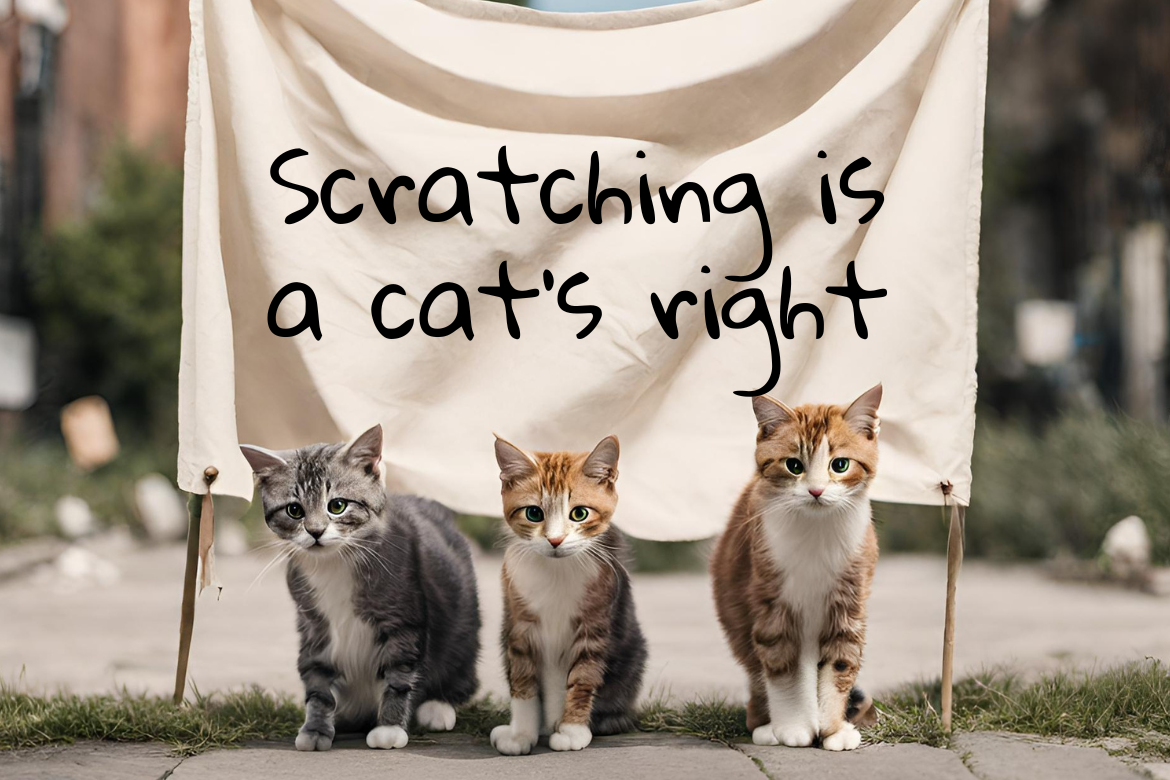“Scratching is a feline’s right!” If furs were to participate in protests for cat rights, they would undoubtedly inscribe this slogan on their banners. Because a cat is a cat – they must scratch. And they do so regardless of whether they have access to a scratcher or not. Therefore, today, fabCats, we will help you figure out which scratcher will be the best for your kitty and what to consider when making scratcher purchases. Check it out!
Does your cat need a scratcher?
If you cherish your furniture, definitely yes 🙂 Scratching is ingrained in the feline nature and serves both to sharpen claws (and remove the outer, dead claw sheath) and to stretch, strengthen muscles, and mark territory. Cats scratch when they are happy, need to release emotions, or simply when they are bored and seek activity or your attention. And it doesn’t matter if the cat is big or small – wild cats and domestic cats, kittens and seniors, outdoor cats, and 100% indoor cats, they all scratch.
What’s important in the philosophy of scratching, cats pay no attention to what they scratch, at least not the way we humans might wish. For a cat, it doesn’t matter whether there are zero, one, or five scratchers within paw’s reach – what matters is whether, in the cat’s eyes, they are properly adapted for scratching, stretching, and marking territory. If not, the sofa will suffer sooner or later.
The perfect scratcher is…? What to consider when choosing a scratcher
Choosing the one purrfect scratcher is by no means straightforward. Although you will find dozens of models on the market in various shapes, sizes, and price ranges, not all scratchers are created equal. And when you look at everything through the lens of your cat’s individual preferences? Oh, fabCat, it can get overwhelming! So, let’s create a simple list of criteria that you should pay attention to when purchasing a scratcher:
- Purpose: The basic function of a scratcher is to provide a surface for scratching. It sounds logical, but contrary to appearances, many products fail at this stage. Why? Because they are too small, too light, or too low for an adult cat. The surface designated for scratching should constitute a significant majority of the entire piece of furniture and be sized according to the cat’s needs. If there are additional huts, beds, or platforms on the scratcher, they should not hinder the cat’s ability to stretch freely.
- Construction: In the case of vertical scratchers, it is said that the height of the post should allow the cat to fully stretch and climb on its hind legs without obstacles like shelves or beds. Horizontal scratchers, on the other hand, must be long and wide enough for the cat to comfortably sit on them, dig in their front claws, and scratch. Smaller ones, often encountered in supermarkets, are sized at most for the needs of young kittens. And what about the shape? In the case of horizontal scratchers, the shape is of secondary importance as long as it does not disrupt the surface available for the cat to scratch.
- Stability: Staying on the subject of construction – cats do not like scratchers that are not stable. Not without reason, large furniture items such as sofas and chairs often fall victim to them. Stabbing a claw into the sofa will not cause it to shift, wobble, or fall on the cat. A stable scratcher is not only a matter of feline comfort but also of their safety! If the scratcher is not an attractive, safe, and equally stable alternative to the sofa, the cat simply won’t be interested.
In the case of horizontal scratchers, the stability and durability of the piece are important as well – the cat feels more comfortable if their scratcher is not moving around under them while they scratch and if it doesn’t bend under their weight, even if they hop on it while running.
- Material: Although vertical scratchers with sisal rope and horizontal scratchers made with corrugated cardboard are the most popular bunch, they are not the only options on the market. You can find scratchers covered with carpet-like material, made of hemp rope, or even with woven banana leaf. It’s important to ensure that the material of the scratcher is safe for the cat – that the scratched sisal rope won’t harm the cat’s paws and that accidentally nibbling on the corrugated cardboard won’t be harmful to the cat due to the glue used in production. At myKotty, we opt for full safety – 100% corrugated cardboard, undyed, and certified glues safe for use in, among other things, food packaging.
- Quality of construction: When buying a scratcher for your cat, you want it to last as long as possible. That’s logical! Therefore, when looking at scratchers, consider the thickness of the rope and posts, the method and quality of fastening, and the possibility of disassembling some elements that may require cleaning (such as plush beds).
For horizontal scratchers with corrugated cardboard, a good quality indicator will be the number of layers of cardboard covering the surface of the scratcher, their density and softness (which also affects the amount of paper confetti produced during scratching), as well as the possibility of turning the scratcher over to the other side so that the cat can enjoy it for as long as possible.
- Aesthetics: We often prioritize aesthetics and there’s nothing wrong with that! After all, by bringing cat furniture into our homes, everyone wants it to blend well with the rest of the furnishings. But in the end, the cat’s needs should take precedence. What’s the point of a beautiful scratcher if the fur won’t want to use it? That’s why at myKotty, we’ve designed scratchers like LUI, VIGO, and TOBI that not only meet cat needs but also look great in your interiors.
Ask your cat’s opinion: choosing a scratcher vs cat preferences
You already know the criteria for choosing scratchers, but do you know, fabCat, that the final word does not belong to you? Because even if we, as the Caretakers, bend over backward, spend a fortune, and cast magical spells, even the quirkiest and requirement-fulfilling scratcher won’t make a furrow if… it’s not what the cat expects! And here comes the issue of knowing your fur’s preferences, fabCat. A completely different scratcher will appeal to a cat who loves all kinds of climbs, and another to a lazy one who spends most of their time napping. So how do you know what your cat will like?
What is their lifestyle? Active cats who like to move around on all planes in the apartment, climb on dressers and shelves, and supervise the world from above definitely need a tall scratcher with viewpoints, as well as classic vertical and horizontal scratchers with plenty of scratching space. Full ceiling scratchers will work well for them, allowing them to climb as high as they want without many obstacles. Lazy, “floor-dwelling” cats prefer horizontal or classic vertical posts that do not require agile climbing and long jumps. If your furball likes to squeeze into tight spaces, LUI will play an additional role here as a hiding place and a good space to play.
What did they scratch before? If you’re just picking up a cat from a breeder or temporary home, ask about their preferences. If you’re planning a new scratcher for your cat, think about what they scratched before. Did they prefer to snag the sofa, or maybe the doormat in the hallway? Did they go crazy for corrugated cardboard, test sisal ropes, or prefer a soft carpet or sofa upholstery? This may matter when choosing the material from which the scratcher is made.
Where do they like to stay most? Scratchers play an important role as domestic signposts – they serve the cat to mark territory. Therefore, they should be placed where the cat likes to stay. For cats who love observing the world, choose a tall vertical scratcher or a mobile horizontal scratcher (like our TOBI), which you can place by the window or on the windowsill. Let the cat enjoy the views. Does the cat spend a lot of time with you, in the living room, or home office? Placing a scratcher nearby is a necessity – the cat will want to mix their scents with yours, so without a scratcher within the paw’s reach, they will start scratching the chair or sofa.
Where do they feel safe? Although scratchers should be placed in important communication paths – where household members are, the cat will scratch them only when they feel safe. There’s no point in putting a scratcher in a cramped hallway if the cat doesn’t like people walking constantly next to their head. Horizontal scratchers also often serve as beds – it’s worth placing at least one in a place where the cat can count on peace during their nap.
What other selection criteria come to your mind, fabCats? What do you focus on when choosing cat accessories, especially scratchers? We would love to hear your opinion! Come and discuss in the comments.




